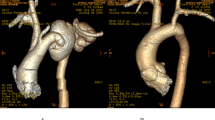Abstract
Background
Intracranial aneurysms are very rare in children. Headache and nausea/vomiting are the most prominent clinical findings. The only effective treatment is obliteration of aneurysm by surgical or endovascular techniques. Interrupted aortic arch is also a rare, congenital cardiovascular malformation characterized by the lack of continuity between the ascending and descending thoracic aorta. Aortic interruption is an uncommon cause of intracranial aneurysm. The course of disease is lethal unless effective collateral flow develops. Long-term survival may be possible with surgical repair.
Method
We report on a 17-year-old boy affected with interrupted aortic arch disease and associated multiple intracranial aneurysms. Both aneurysms clipped successfully. After patient had recovered, he referred to cardiovascular surgery for further treatment.
Conclusion
Surgical or endovascular obliteration remains the main therapy for intracranial aneurysms. Accompanying systemic diseases such as interrupted aortic arch challenge the management of both diseases.


Similar content being viewed by others
References
Baysal T, Kutlu R, Sarac K, Karaman I (2000) Ruptured intracranial aneurysm associated with isolated aortic arch interruption. Neuroradiology 42(11):842–844
Brown JW, Ruzmetov M, Okada Y, Vijay P, Rodefeld MD, Turrentine MW (2006) Outcomes in patients with interrupted aortic arch and associated anomalies: a 20-year experience. Eur J Cardiothorac Surg 29(5):666–673, discussion 673 – 4
Celoria GC, Patton RB (1959) Congenital absence of the aortic arch. Am Heart J 58:407–413
Hetts SW, Narvid J, Sanai N, Lawton MT, Gupta N, Fullerton HJ, Dowd CF, Higashida RT, Halbach VV (2009) Intracranial aneurysms in childhood: 27-year single-institution experience. AJNR Am J Neuroradiol 30(7):1315–1324
Hu WY, Sevick RJ, Tranmer BI, Maitland A, Gray RR (1996) Aortic arch interruption associated with ruptured cerebral aneurysm. Can Assoc Radiol J 47(1):20–23
Lasjaunias P, Wuppalapati S, Alvarez H, Rodesch G, Ozanne A (2005) Intracranial aneurysms in children aged under 15 years: review of 59 consecutive children with 75 aneurysms. Childs Nerv Syst 21(6):437–450
Ling F, Bao YH (1994) Myelopathy and multiple aneurysms associated with aortic arch interruption: case report. Neurosurgery 35(2):310–313, discussion 313
Messner G, Reul GJ, Flamm SD, Gregoric ID, Opfermann UT (2002) Interrupted aortic arch in an adult single-stage extra-anatomic repair. Tex Heart Inst J 29(2):118–121
Mehrotra A, Nair AP, Das KK, Srivastava A, Sahu RN, Kumar R (2012) Clinical and radiological profiles and outcomes in pediatric patients with intracranial aneurysms. J Neurosurg Pediatr. doi:10.3171/2012.7.PEDS11455
Sammig SRJ (1778) Verchiedener in der chirug. Prakt Lehrschule Gemachten Beobb (Vienna) 2:114
Varghese A, Gatzoulis M, Mohiaddin RH (2002) Images in cardiovascular medicine: magnetic resonance angiography of a congenitally interrupted aortic arch. Circulation 06(3):E 9–E 10
White PM, Teasdale E, Wardlaw JM, Easton V (2001) What is the most sensitive non-invasive strategy for the diagnosis of intracranial aneurysms? J Neurol Neurosurg Psychiatry 71(3):322–328
White PM, Wardlaw JM, Easton V (2000) Can noninvasive imaging accurately depict intracranial aneurysms? A systematic review. Radiology 217(2):361–370
White PM, Wardlaw JM, Teasdale E, Sloss S, Cannon J, Easton V (2001) Power transcranial Doppler ultrasound in the detection of intracranial aneurysms. Stroke 32(6):1291–1297
Author information
Authors and Affiliations
Corresponding author
Rights and permissions
About this article
Cite this article
Börcek, A.Ö., Egemen, E., Güngör, G. et al. Intracranial aneurysm in childhood and interrupted aortic arch. Childs Nerv Syst 29, 11–15 (2013). https://doi.org/10.1007/s00381-012-1959-6
Received:
Accepted:
Published:
Issue Date:
DOI: https://doi.org/10.1007/s00381-012-1959-6




